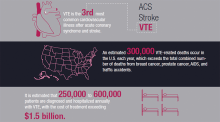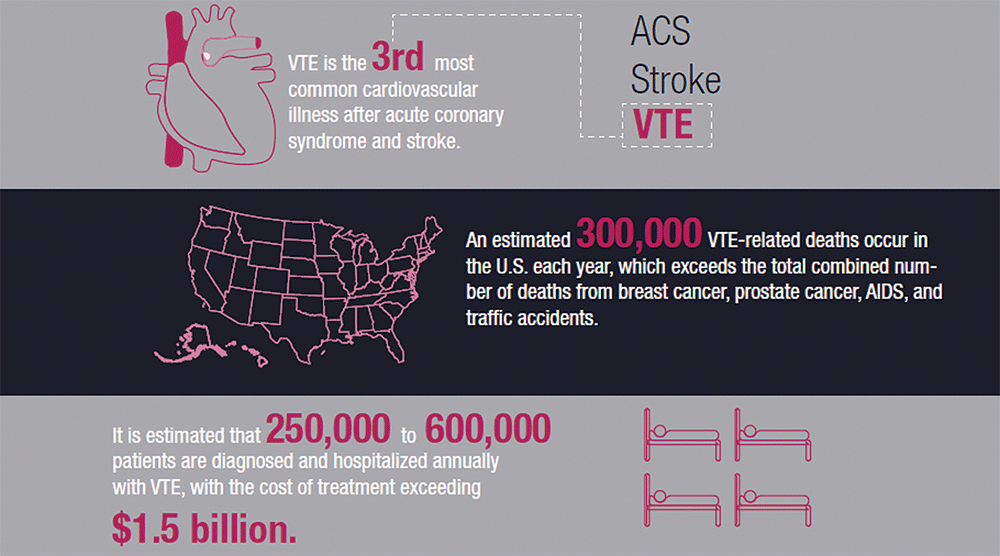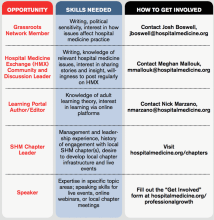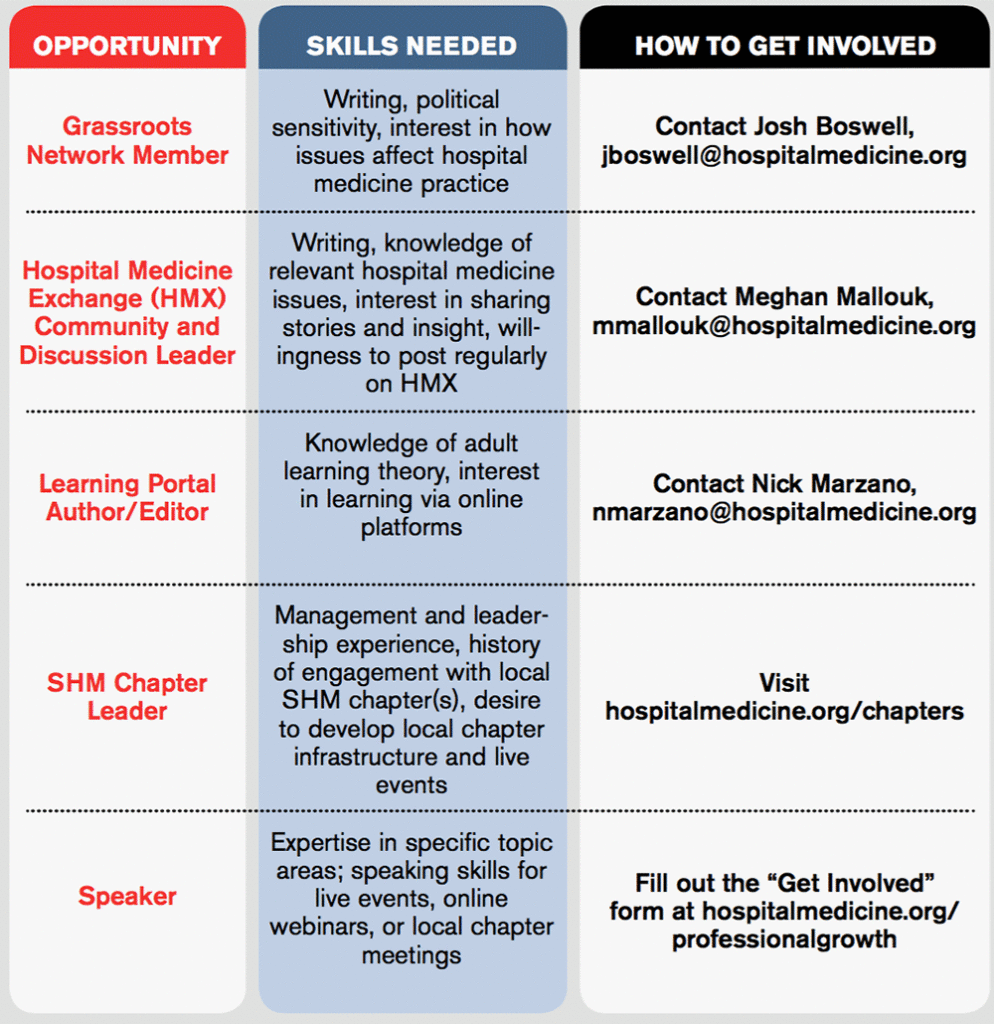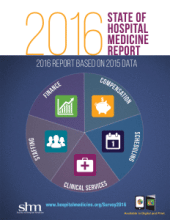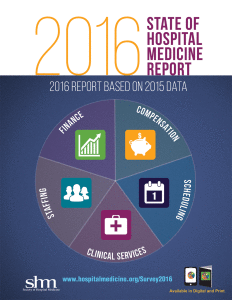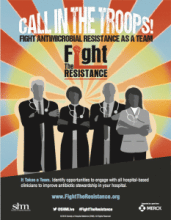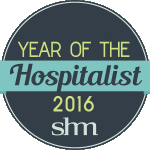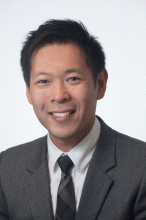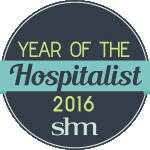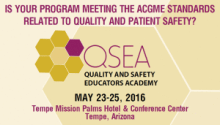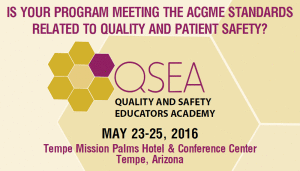User login
Improve Your Treatment of VTE
It is estimated that 250,000 to 600,000 patients are diagnosed and hospitalized annually with venous thromboembolism (VTE), the third most common cardiovascular illness after acute coronary syndrome and stroke. An estimated 300,000 VTE-related deaths occur in the U.S. each year, which exceeds the total number of deaths from breast cancer, prostate cancer, AIDS, and traffic accidents combined.
Communication among care providers is an essential part of medical care; it influences patients’ quality of life and effective disease treatment. Hospitalists educate both patients and providers regarding appropriate steps to take to improve care transitions and reduce any associated risks.
To ensure hospitalists have the latest information about diagnosis, treatment, and transition of inpatients with VTE, SHM is developing:
- An online tool kit, including a literature review; implementation guide; and other references, materials, and tools (e.g., discharge instructions and checklists)
- A webinar series with free CME
To be notified when SHM’s VTE resources become available, visit www.hospitalmedicine.org/VTEtreatment.
It is estimated that 250,000 to 600,000 patients are diagnosed and hospitalized annually with venous thromboembolism (VTE), the third most common cardiovascular illness after acute coronary syndrome and stroke. An estimated 300,000 VTE-related deaths occur in the U.S. each year, which exceeds the total number of deaths from breast cancer, prostate cancer, AIDS, and traffic accidents combined.
Communication among care providers is an essential part of medical care; it influences patients’ quality of life and effective disease treatment. Hospitalists educate both patients and providers regarding appropriate steps to take to improve care transitions and reduce any associated risks.
To ensure hospitalists have the latest information about diagnosis, treatment, and transition of inpatients with VTE, SHM is developing:
- An online tool kit, including a literature review; implementation guide; and other references, materials, and tools (e.g., discharge instructions and checklists)
- A webinar series with free CME
To be notified when SHM’s VTE resources become available, visit www.hospitalmedicine.org/VTEtreatment.
It is estimated that 250,000 to 600,000 patients are diagnosed and hospitalized annually with venous thromboembolism (VTE), the third most common cardiovascular illness after acute coronary syndrome and stroke. An estimated 300,000 VTE-related deaths occur in the U.S. each year, which exceeds the total number of deaths from breast cancer, prostate cancer, AIDS, and traffic accidents combined.
Communication among care providers is an essential part of medical care; it influences patients’ quality of life and effective disease treatment. Hospitalists educate both patients and providers regarding appropriate steps to take to improve care transitions and reduce any associated risks.
To ensure hospitalists have the latest information about diagnosis, treatment, and transition of inpatients with VTE, SHM is developing:
- An online tool kit, including a literature review; implementation guide; and other references, materials, and tools (e.g., discharge instructions and checklists)
- A webinar series with free CME
To be notified when SHM’s VTE resources become available, visit www.hospitalmedicine.org/VTEtreatment.
Take Advantage of SHM's Volunteer Experiences
Are you interested in growing professionally and getting involved in work that you are excited about with colleagues across the country? You are in the driver’s seat as a hospitalist. You are in a position to lead, initiate quality improvement, impact patient outcomes, and advocate for your patients and your specialty in healthcare legislation.
SHM offers a wealth of volunteer experiences that will grow your strengths and interests, sharpen your professional acumen, and enhance your profile. New engagement opportunities are added regularly and represent unique ways to make a difference in hospital medicine. Check out some highlights:
These are just a few potential opportunities available from SHM. To learn more and find one that fits your interests, visit hospitalmedicine.org/professionalgrowth.
Are you interested in growing professionally and getting involved in work that you are excited about with colleagues across the country? You are in the driver’s seat as a hospitalist. You are in a position to lead, initiate quality improvement, impact patient outcomes, and advocate for your patients and your specialty in healthcare legislation.
SHM offers a wealth of volunteer experiences that will grow your strengths and interests, sharpen your professional acumen, and enhance your profile. New engagement opportunities are added regularly and represent unique ways to make a difference in hospital medicine. Check out some highlights:
These are just a few potential opportunities available from SHM. To learn more and find one that fits your interests, visit hospitalmedicine.org/professionalgrowth.
Are you interested in growing professionally and getting involved in work that you are excited about with colleagues across the country? You are in the driver’s seat as a hospitalist. You are in a position to lead, initiate quality improvement, impact patient outcomes, and advocate for your patients and your specialty in healthcare legislation.
SHM offers a wealth of volunteer experiences that will grow your strengths and interests, sharpen your professional acumen, and enhance your profile. New engagement opportunities are added regularly and represent unique ways to make a difference in hospital medicine. Check out some highlights:
These are just a few potential opportunities available from SHM. To learn more and find one that fits your interests, visit hospitalmedicine.org/professionalgrowth.
Sign Up to Receive State of Hospital Medicine Report
Having credible information about how HM groups are structured and operate will benefit the entire healthcare industry and those involved in public policy and research. The survey results will be used by a wide variety of individuals and organizations to make important decisions about practice design and resource allocation.
Visit www.hospitalmedicine.org/survey and complete the notification form to be the first to know when the SOHM report becomes available this fall.
Brett Radler is SHM’s communications coordinator.
Having credible information about how HM groups are structured and operate will benefit the entire healthcare industry and those involved in public policy and research. The survey results will be used by a wide variety of individuals and organizations to make important decisions about practice design and resource allocation.
Visit www.hospitalmedicine.org/survey and complete the notification form to be the first to know when the SOHM report becomes available this fall.
Brett Radler is SHM’s communications coordinator.
Having credible information about how HM groups are structured and operate will benefit the entire healthcare industry and those involved in public policy and research. The survey results will be used by a wide variety of individuals and organizations to make important decisions about practice design and resource allocation.
Visit www.hospitalmedicine.org/survey and complete the notification form to be the first to know when the SOHM report becomes available this fall.
Brett Radler is SHM’s communications coordinator.
Did You Commit to ‘Fight the Resistance’ at HM16?
If you missed HM16 but still want to show your support, visit www.FightTheResistance.org to review SHM’s recommendations for promoting antibiotic stewardship, download copies of our three posters, and submit your case study about how you’re fighting antibiotic resistance in your hospital.
Continue to check www.FightTheResistance.org and follow the #FightTheResistance hashtag on Twitter to learn about new SHM resources to help you continue the fight.
If you missed HM16 but still want to show your support, visit www.FightTheResistance.org to review SHM’s recommendations for promoting antibiotic stewardship, download copies of our three posters, and submit your case study about how you’re fighting antibiotic resistance in your hospital.
Continue to check www.FightTheResistance.org and follow the #FightTheResistance hashtag on Twitter to learn about new SHM resources to help you continue the fight.
If you missed HM16 but still want to show your support, visit www.FightTheResistance.org to review SHM’s recommendations for promoting antibiotic stewardship, download copies of our three posters, and submit your case study about how you’re fighting antibiotic resistance in your hospital.
Continue to check www.FightTheResistance.org and follow the #FightTheResistance hashtag on Twitter to learn about new SHM resources to help you continue the fight.
Jerome C. Siy, MD, SFHM Explores Hospital Medicine’s Global Reach
Hospitalist Jerome C. Siy, MD, SFHM, CHIE, is head of the Department of Hospital Medicine at HealthPartners in Minneapolis-St. Paul, Minn., and chair of SHM’s Practice Management Committee. As a member of SHM for more than 15 years and recipient of SHM’s prestigious Award of Excellence for Clinical Excellence in 2009, Dr. Siy has been a driving force in advancing hospitalist practice and improving patient care in the U.S. and beyond.
Question: What led you to a career in hospital medicine?
Answer: After graduating from the Mayo Graduate School of Medical Education, I started in the med-peds residency program at the University of Minnesota and then transitioned to an internal medicine residency program. It was at the University of Minnesota that I recognized my intense passion for the care of acutely ill hospitalized patients. During my residency, I had the good fortune of finding exceptional hospitalist role models in my program. As I worked with them, my passion for working with hospitalized patients continued to grow; I realized that my ideal job was to work with this group of doctors that I so greatly admired. In 2000, I joined the Department of Hospital Medicine at HealthPartners in Minneapolis-St. Paul and now proudly lead the department.
Q: When did you first get involved with SHM? What value does it bring to your daily practice?
A: When I first joined HealthPartners, Dr. Rusty Holman was our director. He was extremely active in the early days of SHM, when it was known as the National Association of Inpatient Physicians (NAIP). Our team at HealthPartners was fairly small, between 15 and 18 hospitalists, and identified early on with the hospital medicine specialty and NAIP. Many of them are still engaged with SHM 16 years later. As a team, we continue to encourage our entire group of over 90 practitioners, including our PAs and NPs, to get involved with SHM.
At SHM, chances to connect with people exist everywhere. So many hospitalists tell stories about how they went to an SHM meeting and ran into an old friend or medical school colleague that they didn’t realize was a hospitalist. That’s exactly why the SHM community is a fertile ground to build and expand upon ideas for your own program. For example, at HealthPartners, we are embarking on early work with telemedicine. With the network of hospitalists at SHM, I immediately knew colleagues who were working in hospital medicine and was able to visit some of them at their telemedicine specialty center.
Whether you join committees, give a joint lecture, or attend a session at an annual meeting with someone, you are opening yourself up to collaboration that will ultimately lead to better care for patients.
Q: What is one of the most unique or rewarding experiences you have had while practicing hospital medicine?
A: After 10 years at HealthPartners, I took a personal sabbatical to study Chinese in Taiwan for eight months. Even though I was away from my hospital, hospital medicine followed me overseas. While in Asia, I visited contacts in Taiwan and Japan. With the U.S. government just rolling out the Affordable Care Act, I wanted to gain a better understanding of how nationalized healthcare programs impacted care providers and care delivery.
While visiting the University of Osaka and one of the earliest hospital medicine groups at National Taiwan University Hospital, I had the opportunity to explore how a nation’s healthcare system impacted physicians and patients outside the U.S. A major takeaway for me was how important it is for physicians and care providers to be an active part of the healthcare system to create change that can influence the way they practice—and ultimately improve patient care.
In East Asia, whenever there was concern about evolving their healthcare models and the way providers take care of patients, physicians often felt limited in their potential impact. Culturally, senior physicians are the ones more apt to network and influence policy changes. The more physicians felt empowered to influence these senior leaders to address these issues with government officials, the better the chances of driving positive change.
As luck would have it, a hospitalist colleague invited me back to National Taiwan University Hospital in December 2015 to share my knowledge of how the specialty can continue to evolve, taking into consideration the challenges of navigating healthcare systems, physician engagement, and burnout. Even though many of their programs are relatively new, I stressed the fact that the more interactive you are with your healthcare system, the better your chances of engaging the right stakeholders and effectively influencing healthcare policy.
While their definition of burnout may differ slightly from ours in the U.S., they wanted to hear about what we experience in the U.S. and how we address it. I was able to share some techniques we are implementing at HealthPartners to minimize burnout and maximize engagement, including regular department meetings, during which there is an open forum for hot topics. This provides the care team with an avenue to express concerns or address important topics affecting their daily practice. We also have an internal website, where our team can access a repository of resources and a discussion board to share challenges, concerns, and best practices. I also emphasized the importance of professional development and investing in staff to improve their professional career and their patient care.
Q: What are some initiatives you are currently working on that you see having a substantial impact in hospital medicine?
A: As part of the Practice Management Committee at SHM, we are exploring opportunities in telemedicine, especially as it relates to rural care. Telemedicine could be the next big step to provide support for rural hospitalists and rural communities. Geographically speaking, the vast majority of the U.S. is rural, and SHM is poised to have a great impact on the clinicians serving these communities.
Another initiative the committee is working on is developing an update to co-management best practices. As hospital medicine has matured, its scope has changed dramatically, and so has the idea of co-management. We must truly embrace opportunities to improve care across specialties. This is especially important as we welcome younger physicians to the specialty who have not had the benefit of witnessing the evolution of the practice. They need to have a firm hold on the varied daily interactions of a hospitalist and their ultimate impact on outcomes.
At HealthPartners, we are actively addressing hospitalist engagement and burnout. We are mindful of how much our health systems have evolved and how much extra work they have asked us to accommodate. To be proactive, we are trying to be much more creative and innovative with our staffing model and our use of scarce resources in order to provide the best patient care possible. Over the last 16 years, we have worked hard to continue to develop our program but, more important, develop our patient care through the development of our physicians, NPs, and PAs. This includes developing a pathway for residents who wish to become hospitalists, introducing vigorous training for PAs during their student and post-graduate years, and providing staff with the professional development resources they need to expand their skills and knowledge base and stay up-to-date on the latest advances in medicine—whether that is through leadership development or skill straining like point-of-care ultrasound.
Hospital medicine has matured and grown, and our scope has changed dramatically to include observation care, research and academic medicine, telemedicine, palliative care, perioperative medicine, and more. At HealthPartners, we are embracing the opportunity to grow in scope and improve care across specialties.
Q: Given your experience in the U.S. and abroad, what words of advice would you give to medical students and residents considering a career in hospital medicine?
A: As you enter this career out of training, recognize that your potential impact is greater than you ever imagined in medical school. As you continue to grow in your career and make it your own, you will make lasting impacts on your patients and also be extremely creative in what you do. Just as the specialty continues to evolve, so will you. Keep an open mind and embrace the many opportunities that come your way. TH
Brett Radler is SHM’s communications coordinator.
Hospitalist Jerome C. Siy, MD, SFHM, CHIE, is head of the Department of Hospital Medicine at HealthPartners in Minneapolis-St. Paul, Minn., and chair of SHM’s Practice Management Committee. As a member of SHM for more than 15 years and recipient of SHM’s prestigious Award of Excellence for Clinical Excellence in 2009, Dr. Siy has been a driving force in advancing hospitalist practice and improving patient care in the U.S. and beyond.
Question: What led you to a career in hospital medicine?
Answer: After graduating from the Mayo Graduate School of Medical Education, I started in the med-peds residency program at the University of Minnesota and then transitioned to an internal medicine residency program. It was at the University of Minnesota that I recognized my intense passion for the care of acutely ill hospitalized patients. During my residency, I had the good fortune of finding exceptional hospitalist role models in my program. As I worked with them, my passion for working with hospitalized patients continued to grow; I realized that my ideal job was to work with this group of doctors that I so greatly admired. In 2000, I joined the Department of Hospital Medicine at HealthPartners in Minneapolis-St. Paul and now proudly lead the department.
Q: When did you first get involved with SHM? What value does it bring to your daily practice?
A: When I first joined HealthPartners, Dr. Rusty Holman was our director. He was extremely active in the early days of SHM, when it was known as the National Association of Inpatient Physicians (NAIP). Our team at HealthPartners was fairly small, between 15 and 18 hospitalists, and identified early on with the hospital medicine specialty and NAIP. Many of them are still engaged with SHM 16 years later. As a team, we continue to encourage our entire group of over 90 practitioners, including our PAs and NPs, to get involved with SHM.
At SHM, chances to connect with people exist everywhere. So many hospitalists tell stories about how they went to an SHM meeting and ran into an old friend or medical school colleague that they didn’t realize was a hospitalist. That’s exactly why the SHM community is a fertile ground to build and expand upon ideas for your own program. For example, at HealthPartners, we are embarking on early work with telemedicine. With the network of hospitalists at SHM, I immediately knew colleagues who were working in hospital medicine and was able to visit some of them at their telemedicine specialty center.
Whether you join committees, give a joint lecture, or attend a session at an annual meeting with someone, you are opening yourself up to collaboration that will ultimately lead to better care for patients.
Q: What is one of the most unique or rewarding experiences you have had while practicing hospital medicine?
A: After 10 years at HealthPartners, I took a personal sabbatical to study Chinese in Taiwan for eight months. Even though I was away from my hospital, hospital medicine followed me overseas. While in Asia, I visited contacts in Taiwan and Japan. With the U.S. government just rolling out the Affordable Care Act, I wanted to gain a better understanding of how nationalized healthcare programs impacted care providers and care delivery.
While visiting the University of Osaka and one of the earliest hospital medicine groups at National Taiwan University Hospital, I had the opportunity to explore how a nation’s healthcare system impacted physicians and patients outside the U.S. A major takeaway for me was how important it is for physicians and care providers to be an active part of the healthcare system to create change that can influence the way they practice—and ultimately improve patient care.
In East Asia, whenever there was concern about evolving their healthcare models and the way providers take care of patients, physicians often felt limited in their potential impact. Culturally, senior physicians are the ones more apt to network and influence policy changes. The more physicians felt empowered to influence these senior leaders to address these issues with government officials, the better the chances of driving positive change.
As luck would have it, a hospitalist colleague invited me back to National Taiwan University Hospital in December 2015 to share my knowledge of how the specialty can continue to evolve, taking into consideration the challenges of navigating healthcare systems, physician engagement, and burnout. Even though many of their programs are relatively new, I stressed the fact that the more interactive you are with your healthcare system, the better your chances of engaging the right stakeholders and effectively influencing healthcare policy.
While their definition of burnout may differ slightly from ours in the U.S., they wanted to hear about what we experience in the U.S. and how we address it. I was able to share some techniques we are implementing at HealthPartners to minimize burnout and maximize engagement, including regular department meetings, during which there is an open forum for hot topics. This provides the care team with an avenue to express concerns or address important topics affecting their daily practice. We also have an internal website, where our team can access a repository of resources and a discussion board to share challenges, concerns, and best practices. I also emphasized the importance of professional development and investing in staff to improve their professional career and their patient care.
Q: What are some initiatives you are currently working on that you see having a substantial impact in hospital medicine?
A: As part of the Practice Management Committee at SHM, we are exploring opportunities in telemedicine, especially as it relates to rural care. Telemedicine could be the next big step to provide support for rural hospitalists and rural communities. Geographically speaking, the vast majority of the U.S. is rural, and SHM is poised to have a great impact on the clinicians serving these communities.
Another initiative the committee is working on is developing an update to co-management best practices. As hospital medicine has matured, its scope has changed dramatically, and so has the idea of co-management. We must truly embrace opportunities to improve care across specialties. This is especially important as we welcome younger physicians to the specialty who have not had the benefit of witnessing the evolution of the practice. They need to have a firm hold on the varied daily interactions of a hospitalist and their ultimate impact on outcomes.
At HealthPartners, we are actively addressing hospitalist engagement and burnout. We are mindful of how much our health systems have evolved and how much extra work they have asked us to accommodate. To be proactive, we are trying to be much more creative and innovative with our staffing model and our use of scarce resources in order to provide the best patient care possible. Over the last 16 years, we have worked hard to continue to develop our program but, more important, develop our patient care through the development of our physicians, NPs, and PAs. This includes developing a pathway for residents who wish to become hospitalists, introducing vigorous training for PAs during their student and post-graduate years, and providing staff with the professional development resources they need to expand their skills and knowledge base and stay up-to-date on the latest advances in medicine—whether that is through leadership development or skill straining like point-of-care ultrasound.
Hospital medicine has matured and grown, and our scope has changed dramatically to include observation care, research and academic medicine, telemedicine, palliative care, perioperative medicine, and more. At HealthPartners, we are embracing the opportunity to grow in scope and improve care across specialties.
Q: Given your experience in the U.S. and abroad, what words of advice would you give to medical students and residents considering a career in hospital medicine?
A: As you enter this career out of training, recognize that your potential impact is greater than you ever imagined in medical school. As you continue to grow in your career and make it your own, you will make lasting impacts on your patients and also be extremely creative in what you do. Just as the specialty continues to evolve, so will you. Keep an open mind and embrace the many opportunities that come your way. TH
Brett Radler is SHM’s communications coordinator.
Hospitalist Jerome C. Siy, MD, SFHM, CHIE, is head of the Department of Hospital Medicine at HealthPartners in Minneapolis-St. Paul, Minn., and chair of SHM’s Practice Management Committee. As a member of SHM for more than 15 years and recipient of SHM’s prestigious Award of Excellence for Clinical Excellence in 2009, Dr. Siy has been a driving force in advancing hospitalist practice and improving patient care in the U.S. and beyond.
Question: What led you to a career in hospital medicine?
Answer: After graduating from the Mayo Graduate School of Medical Education, I started in the med-peds residency program at the University of Minnesota and then transitioned to an internal medicine residency program. It was at the University of Minnesota that I recognized my intense passion for the care of acutely ill hospitalized patients. During my residency, I had the good fortune of finding exceptional hospitalist role models in my program. As I worked with them, my passion for working with hospitalized patients continued to grow; I realized that my ideal job was to work with this group of doctors that I so greatly admired. In 2000, I joined the Department of Hospital Medicine at HealthPartners in Minneapolis-St. Paul and now proudly lead the department.
Q: When did you first get involved with SHM? What value does it bring to your daily practice?
A: When I first joined HealthPartners, Dr. Rusty Holman was our director. He was extremely active in the early days of SHM, when it was known as the National Association of Inpatient Physicians (NAIP). Our team at HealthPartners was fairly small, between 15 and 18 hospitalists, and identified early on with the hospital medicine specialty and NAIP. Many of them are still engaged with SHM 16 years later. As a team, we continue to encourage our entire group of over 90 practitioners, including our PAs and NPs, to get involved with SHM.
At SHM, chances to connect with people exist everywhere. So many hospitalists tell stories about how they went to an SHM meeting and ran into an old friend or medical school colleague that they didn’t realize was a hospitalist. That’s exactly why the SHM community is a fertile ground to build and expand upon ideas for your own program. For example, at HealthPartners, we are embarking on early work with telemedicine. With the network of hospitalists at SHM, I immediately knew colleagues who were working in hospital medicine and was able to visit some of them at their telemedicine specialty center.
Whether you join committees, give a joint lecture, or attend a session at an annual meeting with someone, you are opening yourself up to collaboration that will ultimately lead to better care for patients.
Q: What is one of the most unique or rewarding experiences you have had while practicing hospital medicine?
A: After 10 years at HealthPartners, I took a personal sabbatical to study Chinese in Taiwan for eight months. Even though I was away from my hospital, hospital medicine followed me overseas. While in Asia, I visited contacts in Taiwan and Japan. With the U.S. government just rolling out the Affordable Care Act, I wanted to gain a better understanding of how nationalized healthcare programs impacted care providers and care delivery.
While visiting the University of Osaka and one of the earliest hospital medicine groups at National Taiwan University Hospital, I had the opportunity to explore how a nation’s healthcare system impacted physicians and patients outside the U.S. A major takeaway for me was how important it is for physicians and care providers to be an active part of the healthcare system to create change that can influence the way they practice—and ultimately improve patient care.
In East Asia, whenever there was concern about evolving their healthcare models and the way providers take care of patients, physicians often felt limited in their potential impact. Culturally, senior physicians are the ones more apt to network and influence policy changes. The more physicians felt empowered to influence these senior leaders to address these issues with government officials, the better the chances of driving positive change.
As luck would have it, a hospitalist colleague invited me back to National Taiwan University Hospital in December 2015 to share my knowledge of how the specialty can continue to evolve, taking into consideration the challenges of navigating healthcare systems, physician engagement, and burnout. Even though many of their programs are relatively new, I stressed the fact that the more interactive you are with your healthcare system, the better your chances of engaging the right stakeholders and effectively influencing healthcare policy.
While their definition of burnout may differ slightly from ours in the U.S., they wanted to hear about what we experience in the U.S. and how we address it. I was able to share some techniques we are implementing at HealthPartners to minimize burnout and maximize engagement, including regular department meetings, during which there is an open forum for hot topics. This provides the care team with an avenue to express concerns or address important topics affecting their daily practice. We also have an internal website, where our team can access a repository of resources and a discussion board to share challenges, concerns, and best practices. I also emphasized the importance of professional development and investing in staff to improve their professional career and their patient care.
Q: What are some initiatives you are currently working on that you see having a substantial impact in hospital medicine?
A: As part of the Practice Management Committee at SHM, we are exploring opportunities in telemedicine, especially as it relates to rural care. Telemedicine could be the next big step to provide support for rural hospitalists and rural communities. Geographically speaking, the vast majority of the U.S. is rural, and SHM is poised to have a great impact on the clinicians serving these communities.
Another initiative the committee is working on is developing an update to co-management best practices. As hospital medicine has matured, its scope has changed dramatically, and so has the idea of co-management. We must truly embrace opportunities to improve care across specialties. This is especially important as we welcome younger physicians to the specialty who have not had the benefit of witnessing the evolution of the practice. They need to have a firm hold on the varied daily interactions of a hospitalist and their ultimate impact on outcomes.
At HealthPartners, we are actively addressing hospitalist engagement and burnout. We are mindful of how much our health systems have evolved and how much extra work they have asked us to accommodate. To be proactive, we are trying to be much more creative and innovative with our staffing model and our use of scarce resources in order to provide the best patient care possible. Over the last 16 years, we have worked hard to continue to develop our program but, more important, develop our patient care through the development of our physicians, NPs, and PAs. This includes developing a pathway for residents who wish to become hospitalists, introducing vigorous training for PAs during their student and post-graduate years, and providing staff with the professional development resources they need to expand their skills and knowledge base and stay up-to-date on the latest advances in medicine—whether that is through leadership development or skill straining like point-of-care ultrasound.
Hospital medicine has matured and grown, and our scope has changed dramatically to include observation care, research and academic medicine, telemedicine, palliative care, perioperative medicine, and more. At HealthPartners, we are embracing the opportunity to grow in scope and improve care across specialties.
Q: Given your experience in the U.S. and abroad, what words of advice would you give to medical students and residents considering a career in hospital medicine?
A: As you enter this career out of training, recognize that your potential impact is greater than you ever imagined in medical school. As you continue to grow in your career and make it your own, you will make lasting impacts on your patients and also be extremely creative in what you do. Just as the specialty continues to evolve, so will you. Keep an open mind and embrace the many opportunities that come your way. TH
Brett Radler is SHM’s communications coordinator.
10 Reasons to Attend the Quality and Safety Educators Academy
Teaching quality improvement and patient safety is no longer an elective—it’s a necessity. The Quality and Safety Educators Academy (QSEA, sites.hospitalmedicine.org/qsea) provides medical educators with the knowledge and tools to integrate quality improvement and safety concepts into their curricula. This year, QSEA will be held May 23–25 at Tempe Mission Palms Hotel and Conference Center in Arizona.
Here are the top 10 reasons you can’t afford to miss it—and will be glad you went!
- Unparalleled Education: Develop and refine your knowledge in the field of quality and patient safety.
- Curriculum Development: Return to your institution with a collection of new curriculum ideas from QSEA faculty and peers.
- Professional Development: Spend focused time developing and reflecting on your career goals as a physician educator in quality and safety.
- Networking: Build a network of quality and safety educators with both faculty mentors and colleagues with similar career interests.
- Institutional Support: Learn strategies to engage your institutional and program leaders to support and implement a quality and patient safety curriculum to meet the Accreditation Council for Graduate Medical Education (ACGME) Next Accreditation System/Clinical Learning Environment Review (CLER) expectations and improve patient care.
- Hands-On Activities: Dive in to an interactive learning environment with a 10-to-1 student-to-faculty ratio, including facilitated large group sessions, small group activities, and mentor groups.
- Variety of Content: Each day features a variety of topics, such as the principles of quality improvement and patient safety, mentoring trainees in quality improvement project work, high-value care curriculum, curriculum development and assessment in medical education, and many others.
- Distinguished Faculty: All sessions are led by experienced physicians known for their ability to practice and teach quality improvement and patient safety, mentor junior faculty, and guide educators in curriculum development.
- Valuable Resources: Leave with a tool kit of educational resources for quality and safety education.
- Desert Beauty: Enjoy sunny Tempe, Arizona, or travel to nearby Phoenix or Scottsdale!
It’s no surprise that QSEA sold out each of the past four years, so don’t delay—it’s almost here! Register online or via phone at 800-843-3360. Questions? Email [email protected].
Teaching quality improvement and patient safety is no longer an elective—it’s a necessity. The Quality and Safety Educators Academy (QSEA, sites.hospitalmedicine.org/qsea) provides medical educators with the knowledge and tools to integrate quality improvement and safety concepts into their curricula. This year, QSEA will be held May 23–25 at Tempe Mission Palms Hotel and Conference Center in Arizona.
Here are the top 10 reasons you can’t afford to miss it—and will be glad you went!
- Unparalleled Education: Develop and refine your knowledge in the field of quality and patient safety.
- Curriculum Development: Return to your institution with a collection of new curriculum ideas from QSEA faculty and peers.
- Professional Development: Spend focused time developing and reflecting on your career goals as a physician educator in quality and safety.
- Networking: Build a network of quality and safety educators with both faculty mentors and colleagues with similar career interests.
- Institutional Support: Learn strategies to engage your institutional and program leaders to support and implement a quality and patient safety curriculum to meet the Accreditation Council for Graduate Medical Education (ACGME) Next Accreditation System/Clinical Learning Environment Review (CLER) expectations and improve patient care.
- Hands-On Activities: Dive in to an interactive learning environment with a 10-to-1 student-to-faculty ratio, including facilitated large group sessions, small group activities, and mentor groups.
- Variety of Content: Each day features a variety of topics, such as the principles of quality improvement and patient safety, mentoring trainees in quality improvement project work, high-value care curriculum, curriculum development and assessment in medical education, and many others.
- Distinguished Faculty: All sessions are led by experienced physicians known for their ability to practice and teach quality improvement and patient safety, mentor junior faculty, and guide educators in curriculum development.
- Valuable Resources: Leave with a tool kit of educational resources for quality and safety education.
- Desert Beauty: Enjoy sunny Tempe, Arizona, or travel to nearby Phoenix or Scottsdale!
It’s no surprise that QSEA sold out each of the past four years, so don’t delay—it’s almost here! Register online or via phone at 800-843-3360. Questions? Email [email protected].
Teaching quality improvement and patient safety is no longer an elective—it’s a necessity. The Quality and Safety Educators Academy (QSEA, sites.hospitalmedicine.org/qsea) provides medical educators with the knowledge and tools to integrate quality improvement and safety concepts into their curricula. This year, QSEA will be held May 23–25 at Tempe Mission Palms Hotel and Conference Center in Arizona.
Here are the top 10 reasons you can’t afford to miss it—and will be glad you went!
- Unparalleled Education: Develop and refine your knowledge in the field of quality and patient safety.
- Curriculum Development: Return to your institution with a collection of new curriculum ideas from QSEA faculty and peers.
- Professional Development: Spend focused time developing and reflecting on your career goals as a physician educator in quality and safety.
- Networking: Build a network of quality and safety educators with both faculty mentors and colleagues with similar career interests.
- Institutional Support: Learn strategies to engage your institutional and program leaders to support and implement a quality and patient safety curriculum to meet the Accreditation Council for Graduate Medical Education (ACGME) Next Accreditation System/Clinical Learning Environment Review (CLER) expectations and improve patient care.
- Hands-On Activities: Dive in to an interactive learning environment with a 10-to-1 student-to-faculty ratio, including facilitated large group sessions, small group activities, and mentor groups.
- Variety of Content: Each day features a variety of topics, such as the principles of quality improvement and patient safety, mentoring trainees in quality improvement project work, high-value care curriculum, curriculum development and assessment in medical education, and many others.
- Distinguished Faculty: All sessions are led by experienced physicians known for their ability to practice and teach quality improvement and patient safety, mentor junior faculty, and guide educators in curriculum development.
- Valuable Resources: Leave with a tool kit of educational resources for quality and safety education.
- Desert Beauty: Enjoy sunny Tempe, Arizona, or travel to nearby Phoenix or Scottsdale!
It’s no surprise that QSEA sold out each of the past four years, so don’t delay—it’s almost here! Register online or via phone at 800-843-3360. Questions? Email [email protected].
Hospitalist Engagement Benchmarking Service Returns for 2016
Engaged hospitalists drive quality care, and SHM has the tools to help you assess the level of engagement of hospitalists in your hospital medicine group. SHM offered a Hospitalist Engagement Benchmarking Service in 2015 and analyzed engagement of approximately 1,500 hospitalists. Organizational climate, care quality, autonomy, effective motivation, and burnout risk are just a few of the domains that were benchmarked.
“The engagement survey opened conversations about everything from how we relate to the C-suite to what we can do to sustain teamwork,” says Erin Stucky Fisher, MD, MHM, pediatric hospitalist at Rady Children’s Hospital-San Diego. “[It] highlighted what was working well and identified what needs work.”
More than 80% of respondents indicated that they will utilize the service again and plan to recommend it to a colleague. Help ensure hospitalists are engaged in your hospital medicine group by registering now for the next cohort at www.hospitalmedicine.org/engage. TH
Brett Radler is SHM’s communications coordinator.
Engaged hospitalists drive quality care, and SHM has the tools to help you assess the level of engagement of hospitalists in your hospital medicine group. SHM offered a Hospitalist Engagement Benchmarking Service in 2015 and analyzed engagement of approximately 1,500 hospitalists. Organizational climate, care quality, autonomy, effective motivation, and burnout risk are just a few of the domains that were benchmarked.
“The engagement survey opened conversations about everything from how we relate to the C-suite to what we can do to sustain teamwork,” says Erin Stucky Fisher, MD, MHM, pediatric hospitalist at Rady Children’s Hospital-San Diego. “[It] highlighted what was working well and identified what needs work.”
More than 80% of respondents indicated that they will utilize the service again and plan to recommend it to a colleague. Help ensure hospitalists are engaged in your hospital medicine group by registering now for the next cohort at www.hospitalmedicine.org/engage. TH
Brett Radler is SHM’s communications coordinator.
Engaged hospitalists drive quality care, and SHM has the tools to help you assess the level of engagement of hospitalists in your hospital medicine group. SHM offered a Hospitalist Engagement Benchmarking Service in 2015 and analyzed engagement of approximately 1,500 hospitalists. Organizational climate, care quality, autonomy, effective motivation, and burnout risk are just a few of the domains that were benchmarked.
“The engagement survey opened conversations about everything from how we relate to the C-suite to what we can do to sustain teamwork,” says Erin Stucky Fisher, MD, MHM, pediatric hospitalist at Rady Children’s Hospital-San Diego. “[It] highlighted what was working well and identified what needs work.”
More than 80% of respondents indicated that they will utilize the service again and plan to recommend it to a colleague. Help ensure hospitalists are engaged in your hospital medicine group by registering now for the next cohort at www.hospitalmedicine.org/engage. TH
Brett Radler is SHM’s communications coordinator.
Leadership Academy 2016 heads to Florida in October
Ever wish you had more leadership training in medical school or your residency programs? Feel a bit overwhelmed when developing operational plans for your hospital or negotiating important contracts? Join SHM in sunny Lake Buena Vista, Fla., October 24–27, for its esteemed Leadership Academy (www.shmleadershipacademy.org). SHM Leadership Academy prepares clinicians, academicians, and administrators with vital leadership skills traditionally not taught throughout the course of medical training, tailored specifically to hospital medicine.
“SHM’s Leadership Academy teaches leadership skills for individuals all across the spectrum of the hospital team. My experience helped me to raise the bar not only to benefit myself but also my institution and especially my patients,” says Ron Greeno, MD, MHM. “I highly recommend this experience to any hospital medicine professionals who aspire to take their leadership skills to the next level.”
All three courses run concurrently over the span of the four days and are led by world-renowned faculty. This expanded meeting will provide attendees with unprecedented networking opportunities with hundreds of colleagues and enhanced career development.
Available Leadership Academy courses include:
- Leadership Foundations, a four-day course that serves as the first step in your leadership journey. Attendees learn how to evaluate personal leadership strengths and weaknesses, create and execute a communication strategy for key team members, understand key hospital drivers, examine how hospital metrics are derived, and much more. Attendees are divided into smaller moderated groups to ensure meaningful, relevant application of concepts to hands-on activities.
- Advanced Leadership: Influential Management, a course that builds skills around driving culture change through specific leadership behaviors and actions, financial storytelling, engaging in effective professional negotiation activities with proven techniques, and more through world-renowned faculty and applied exercises.
(Prerequisite: Leadership Foundations or an advanced management degree upon course director approval)
- Advanced Leadership: Mastering Teamwork, a course developed in response to high demand from previous Leadership Academy attendees. Participants learn how to critically assess program growth opportunities and develop operational plans; utilize the principles of SWARM intelligence; lead, manage, and motivate teams in complex hospital environments; and develop effective communication strategies.
(Prerequisite: Leadership Foundations or an advanced management degree upon course director approval.)
SHM members receive reduced rates for course tuition. For more information on how to register, visit www.SHMLeadershipAcademy.org.
Ever wish you had more leadership training in medical school or your residency programs? Feel a bit overwhelmed when developing operational plans for your hospital or negotiating important contracts? Join SHM in sunny Lake Buena Vista, Fla., October 24–27, for its esteemed Leadership Academy (www.shmleadershipacademy.org). SHM Leadership Academy prepares clinicians, academicians, and administrators with vital leadership skills traditionally not taught throughout the course of medical training, tailored specifically to hospital medicine.
“SHM’s Leadership Academy teaches leadership skills for individuals all across the spectrum of the hospital team. My experience helped me to raise the bar not only to benefit myself but also my institution and especially my patients,” says Ron Greeno, MD, MHM. “I highly recommend this experience to any hospital medicine professionals who aspire to take their leadership skills to the next level.”
All three courses run concurrently over the span of the four days and are led by world-renowned faculty. This expanded meeting will provide attendees with unprecedented networking opportunities with hundreds of colleagues and enhanced career development.
Available Leadership Academy courses include:
- Leadership Foundations, a four-day course that serves as the first step in your leadership journey. Attendees learn how to evaluate personal leadership strengths and weaknesses, create and execute a communication strategy for key team members, understand key hospital drivers, examine how hospital metrics are derived, and much more. Attendees are divided into smaller moderated groups to ensure meaningful, relevant application of concepts to hands-on activities.
- Advanced Leadership: Influential Management, a course that builds skills around driving culture change through specific leadership behaviors and actions, financial storytelling, engaging in effective professional negotiation activities with proven techniques, and more through world-renowned faculty and applied exercises.
(Prerequisite: Leadership Foundations or an advanced management degree upon course director approval)
- Advanced Leadership: Mastering Teamwork, a course developed in response to high demand from previous Leadership Academy attendees. Participants learn how to critically assess program growth opportunities and develop operational plans; utilize the principles of SWARM intelligence; lead, manage, and motivate teams in complex hospital environments; and develop effective communication strategies.
(Prerequisite: Leadership Foundations or an advanced management degree upon course director approval.)
SHM members receive reduced rates for course tuition. For more information on how to register, visit www.SHMLeadershipAcademy.org.
Ever wish you had more leadership training in medical school or your residency programs? Feel a bit overwhelmed when developing operational plans for your hospital or negotiating important contracts? Join SHM in sunny Lake Buena Vista, Fla., October 24–27, for its esteemed Leadership Academy (www.shmleadershipacademy.org). SHM Leadership Academy prepares clinicians, academicians, and administrators with vital leadership skills traditionally not taught throughout the course of medical training, tailored specifically to hospital medicine.
“SHM’s Leadership Academy teaches leadership skills for individuals all across the spectrum of the hospital team. My experience helped me to raise the bar not only to benefit myself but also my institution and especially my patients,” says Ron Greeno, MD, MHM. “I highly recommend this experience to any hospital medicine professionals who aspire to take their leadership skills to the next level.”
All three courses run concurrently over the span of the four days and are led by world-renowned faculty. This expanded meeting will provide attendees with unprecedented networking opportunities with hundreds of colleagues and enhanced career development.
Available Leadership Academy courses include:
- Leadership Foundations, a four-day course that serves as the first step in your leadership journey. Attendees learn how to evaluate personal leadership strengths and weaknesses, create and execute a communication strategy for key team members, understand key hospital drivers, examine how hospital metrics are derived, and much more. Attendees are divided into smaller moderated groups to ensure meaningful, relevant application of concepts to hands-on activities.
- Advanced Leadership: Influential Management, a course that builds skills around driving culture change through specific leadership behaviors and actions, financial storytelling, engaging in effective professional negotiation activities with proven techniques, and more through world-renowned faculty and applied exercises.
(Prerequisite: Leadership Foundations or an advanced management degree upon course director approval)
- Advanced Leadership: Mastering Teamwork, a course developed in response to high demand from previous Leadership Academy attendees. Participants learn how to critically assess program growth opportunities and develop operational plans; utilize the principles of SWARM intelligence; lead, manage, and motivate teams in complex hospital environments; and develop effective communication strategies.
(Prerequisite: Leadership Foundations or an advanced management degree upon course director approval.)
SHM members receive reduced rates for course tuition. For more information on how to register, visit www.SHMLeadershipAcademy.org.
Begin Your Journey as an SHM Ambassador
Beginning March 1 and running through December 31, all active SHM members can earn 2017–2018 dues credits and special recognition for recruiting new physician, physician assistant, nurse practitioner, pharmacist, or affiliate members. Active members will be eligible for:
- A $35 credit toward 2017–2018 dues when recruiting 1 new member
- A $50 credit toward 2017–2018 dues when recruiting 2–4 new members
- A $75 credit toward 2017–2018 dues when recruiting 5–9 new members
- A $125 credit toward 2017–2018 dues when recruiting 10+ new members
For each member recruited, individuals will receive one entry into a grand-prize drawing to receive complimentary registration to HM17 in Las Vegas.
To be counted as a referral, the new member referral must:
- Be a brand-new member to SHM (past members whose membership has lapsed do not qualify)
- Register as a physician, physician assistant, nurse practitioner, pharmacist, or affiliate member
- Include an active member’s name in the “referred by” field on a printed application or the online join form
- Join between March 1, 2016, and December 31, 2016
SHM members are not eligible for dues credits through this program for member referrals attributed to free memberships received as a result of HM17 registrations.
Begin your journey as an SHM Ambassador today at www.hospitalmedicine.org/MAP.
Beginning March 1 and running through December 31, all active SHM members can earn 2017–2018 dues credits and special recognition for recruiting new physician, physician assistant, nurse practitioner, pharmacist, or affiliate members. Active members will be eligible for:
- A $35 credit toward 2017–2018 dues when recruiting 1 new member
- A $50 credit toward 2017–2018 dues when recruiting 2–4 new members
- A $75 credit toward 2017–2018 dues when recruiting 5–9 new members
- A $125 credit toward 2017–2018 dues when recruiting 10+ new members
For each member recruited, individuals will receive one entry into a grand-prize drawing to receive complimentary registration to HM17 in Las Vegas.
To be counted as a referral, the new member referral must:
- Be a brand-new member to SHM (past members whose membership has lapsed do not qualify)
- Register as a physician, physician assistant, nurse practitioner, pharmacist, or affiliate member
- Include an active member’s name in the “referred by” field on a printed application or the online join form
- Join between March 1, 2016, and December 31, 2016
SHM members are not eligible for dues credits through this program for member referrals attributed to free memberships received as a result of HM17 registrations.
Begin your journey as an SHM Ambassador today at www.hospitalmedicine.org/MAP.
Beginning March 1 and running through December 31, all active SHM members can earn 2017–2018 dues credits and special recognition for recruiting new physician, physician assistant, nurse practitioner, pharmacist, or affiliate members. Active members will be eligible for:
- A $35 credit toward 2017–2018 dues when recruiting 1 new member
- A $50 credit toward 2017–2018 dues when recruiting 2–4 new members
- A $75 credit toward 2017–2018 dues when recruiting 5–9 new members
- A $125 credit toward 2017–2018 dues when recruiting 10+ new members
For each member recruited, individuals will receive one entry into a grand-prize drawing to receive complimentary registration to HM17 in Las Vegas.
To be counted as a referral, the new member referral must:
- Be a brand-new member to SHM (past members whose membership has lapsed do not qualify)
- Register as a physician, physician assistant, nurse practitioner, pharmacist, or affiliate member
- Include an active member’s name in the “referred by” field on a printed application or the online join form
- Join between March 1, 2016, and December 31, 2016
SHM members are not eligible for dues credits through this program for member referrals attributed to free memberships received as a result of HM17 registrations.
Begin your journey as an SHM Ambassador today at www.hospitalmedicine.org/MAP.
Start Preparing for the Focused Practice in Hospital Medicine Exam
SHM recently developed the only maintenance of certification (MOC) exam by hospitalists for hospitalists. SHM SPARK is a fantastic complement to MOC tools already on the market and will help hospitalists succeed in the upcoming exam; it delivers access to relevant hospital medicine review content to enhance patient care while at the same time giving you the flexibility to fill your knowledge gaps and study needs at your own pace.
Featuring a unique online platform, SHM SPARK offers 175 vignette-style multiple-choice questions that bridge the primary knowledge gaps found within existing MOC exam-preparation products today. Other preparation tools are targeted toward the ABIM Internal Medicine exam and cover only roughly 60% of the Focused Practice in Hospital Medicine exam.
SHM SPARK is designed to serve as a supplemental study guide providing targeted study in the remaining roughly 40% of the Focused Practice in Hospital Medicine exam blueprint.
SHM SPARK provides in-depth review on the following systems-based content:
- Palliative care, ethics, and decision making
- Patient safety
- Perioperative care and consultative co-management
- Quality, cost, and clinical reasoning
The tool’s self-study provides detailed learning objectives and discussion points and allows users to define individual areas of strengths and weaknesses. Users will have the option to claim applicable ABIM MOC Part II Medical Knowledge points as they complete each module with a minimum passing score of 80%. After successful completion of all four modules, participants may claim up to 10.5 AMA PRA Category 1 Credits.
Order SPARK today at www.hospitalmedicine.org/SPARK.
SHM recently developed the only maintenance of certification (MOC) exam by hospitalists for hospitalists. SHM SPARK is a fantastic complement to MOC tools already on the market and will help hospitalists succeed in the upcoming exam; it delivers access to relevant hospital medicine review content to enhance patient care while at the same time giving you the flexibility to fill your knowledge gaps and study needs at your own pace.
Featuring a unique online platform, SHM SPARK offers 175 vignette-style multiple-choice questions that bridge the primary knowledge gaps found within existing MOC exam-preparation products today. Other preparation tools are targeted toward the ABIM Internal Medicine exam and cover only roughly 60% of the Focused Practice in Hospital Medicine exam.
SHM SPARK is designed to serve as a supplemental study guide providing targeted study in the remaining roughly 40% of the Focused Practice in Hospital Medicine exam blueprint.
SHM SPARK provides in-depth review on the following systems-based content:
- Palliative care, ethics, and decision making
- Patient safety
- Perioperative care and consultative co-management
- Quality, cost, and clinical reasoning
The tool’s self-study provides detailed learning objectives and discussion points and allows users to define individual areas of strengths and weaknesses. Users will have the option to claim applicable ABIM MOC Part II Medical Knowledge points as they complete each module with a minimum passing score of 80%. After successful completion of all four modules, participants may claim up to 10.5 AMA PRA Category 1 Credits.
Order SPARK today at www.hospitalmedicine.org/SPARK.
SHM recently developed the only maintenance of certification (MOC) exam by hospitalists for hospitalists. SHM SPARK is a fantastic complement to MOC tools already on the market and will help hospitalists succeed in the upcoming exam; it delivers access to relevant hospital medicine review content to enhance patient care while at the same time giving you the flexibility to fill your knowledge gaps and study needs at your own pace.
Featuring a unique online platform, SHM SPARK offers 175 vignette-style multiple-choice questions that bridge the primary knowledge gaps found within existing MOC exam-preparation products today. Other preparation tools are targeted toward the ABIM Internal Medicine exam and cover only roughly 60% of the Focused Practice in Hospital Medicine exam.
SHM SPARK is designed to serve as a supplemental study guide providing targeted study in the remaining roughly 40% of the Focused Practice in Hospital Medicine exam blueprint.
SHM SPARK provides in-depth review on the following systems-based content:
- Palliative care, ethics, and decision making
- Patient safety
- Perioperative care and consultative co-management
- Quality, cost, and clinical reasoning
The tool’s self-study provides detailed learning objectives and discussion points and allows users to define individual areas of strengths and weaknesses. Users will have the option to claim applicable ABIM MOC Part II Medical Knowledge points as they complete each module with a minimum passing score of 80%. After successful completion of all four modules, participants may claim up to 10.5 AMA PRA Category 1 Credits.
Order SPARK today at www.hospitalmedicine.org/SPARK.
